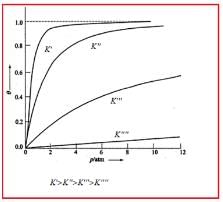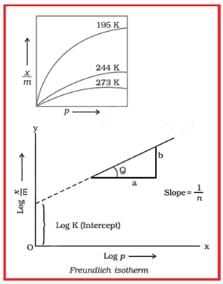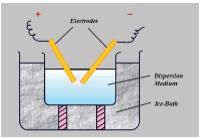Surface Chemistry Class 12 Notes Chemistry
ADSORPTION
Reversible and irreversible adsorption
The adsorption is reversible, if the adsorbent can be easily removed from the surface of the adsorbent by physical methods. It is called irreversible adsorption, if the adsorbate can not be removed from the surface of the adsorbent.
A gas adsorbed on a solid surface can be completely removed in vacuum. It is, therefore, reversible adsorption. Examples of irreversible adsorption are adsorption of oxygen on tungsten adsorbate and adsorption of CO on tungsten surface
Adsorbent, Adsorbate and Interface
- The substances upon whose surface the change of concentration occurs, is called absorbent.
- The substance taken up on the surface is call adsorbate.
- The common surface between the two phases where the adsorbed molecules concentrate is called the interface.
Physisorption and Chemosorption:
Physisorption | Chemisorption |
Only van der Waals force are present between adsorbate and surface of adsorbent | Chemical bonds are formed between adsorbate and surface of adsorbent |
Low enthalpy of adsorption ie, in the order of 20 kjmol-1. | High enthalpy of adsorption i.e, order of 200 kjmol-1. |
Reversible | Irreversible |
It is usually takes place at low temperature and does not require any activation energy. | It takes place at high temperature and require activation energy.. |
Multi molecular layer of adsorbate are formed on the surface | Only monomolecular layers are formed. |
Not specific. | Highly specific. |
Langmular Isotherm:
If A, B & AB represents the adsorbed, absorbent and the absorbed – adsorbent complex then,
A + B ↔AB
ka = Equilibrium constant for adsorption = [AB]/[A][B]
kd = Equilibrium constant for desorption = [A][B]/[AB]
K = Distribution coefficient = ka/kb
Θ = Fraction of the surface of adsorbent available for adsorption.
P = pressure
So,
Θ= KP/(1+KP) (Langmular Equation)
Freundlich Isotherm:
x= Mass of the gas adsorbed
m = Mass of absorbent
p = Pressure
K and n = constants
x/m =k.p(1/n) [n >1]
or
log x/m = log k + 1/n log P
Factors Affecting Adsorption:
- Temperature: An increase of temperature leads to a decrease in amount adsorbed and vice – versa.
- Pressure or concentration: It has been found that in most cases, the adsorption is reversible and an increased pressure of a gases vapour or an increase in concentration of a solute causes increased adsorption.
- Nature of Adsorbate and Adsorbent: The amount of the gas adsorbed depends upon the nature of adsorbent and the gas (adsorbate), which is to be adsorbed. It has been found that easily liquifiable gases such as NH3, HCl, Cl2 , SO2 CO2 etc. are more readily adsorbed than so the called permanent gases such as O2,N2, H2 etc. This is because that molecules of the former type of gases have greater Vander waal’s or molecular force of attraction.
Colloids
Dispersed Phase:
The phase which is dispersed or scattered through the dispersion medium is called Dispersed phase or discontinuous phase.
Dispersion Medium:
The phase in which the scattering is done is called the dispersion medium or continuous medium.
Dispersed Phase | Dispersion Medium | Name | Typical example |
Solid | Liquid | Sol | Gold sol, Mud, Fe(OH)3 sol, |
Solid | Solid | Solid sol | Gems, Ruby glass, Minerals |
Solid | Gas | Aero sols | Smoke (Carbon in air) Volcanic dust |
Liquid | Solid | Gel | Curd, Cheese, Jellies |
Liquid | Liquid | Emulsion | Milk, water in benzene, cream |
Liquid | Gas | Liquid aerosol | Clouds, fog (water in air) mist |
Gas | Solid | Solid foam | Lava, Pumica |
Gas | Liquid | Foam | Froth on beer , whipped cream |
Lyophobic and Lyophilic Colloids:
Those substance whose colloidal solution cannot be prepared by bringing them in contact with a solvent are called Lyophobic (disliking, fearing or hating a liquid). On the other hand those substances whose colloidal solutions can be prepared by bringing them in contact with a liquid solvent are called lyophilic colloids (loving a solvent).
Emulsions:
- Emulsion of oil in water: Those emulsions in which the dispersed phase is oil and water is the dispersion medium. These emulsion are generally represented as O in W emulsions. Examples are milk, vanishing cream etc.
- Emulsions of water in oil: Those emulsion in which the dispersed phase is water while oil is the dispersion medium. These emulsion are generally represented as W in O emulsions. Examples are butter, ice cream etc.
Difference between True Solutions, Suspension & Colloids
True solution | Suspension | Colloid |
Homogenous | Heterogeneous | Heterogeneous |
Particle size less than 1nm | Particle size more than 1000nm | Particle size between 1-1000nm |
Don’t settle down | Settle down under the influence of gravity | Don’t settle down |
Complements cannot be separated out by filtration | Can be filtered | Can be filtered using special filter papers |
Don’t show tyndrall effect | Show tyndrall effect | Show tyndrall effect |
Methods of preparation of colloids
Chemical Methods:
Bredig's method:
An electric arc is struck between two metallic electrodes immersed in dispersion medium. The arc produced vapourises the metal which on further condensation produces particles of colloidal size.
- Peptization:
Process of converting a precipitate into colloidal sol by shaking it with electrolyte
in dispersion medium.
Hardy Schulze Rule:
- Ion carrying charge opposite to the colloidal particle has capacity to coagulate the colloid.
- Greater the valency of ion, greater will be the coagulating power.
- Gold Number: The minimum amount of lyophilic colloid in milligrams which can prevent the coagulation of 10 ml gold sol against 1 ml of 10% NaCl solution.
Surfactants
substances which gets preferentially adsorbed at the air – water and solid – water interfaces forming an oriented monolayer where the hydrophilic groups point towards the aqueous phase and the hydrocarbon chain point towards the air or towards the oil phase.
- Anionic surfactants : NSodium salts of higher fatty acids such as sodium palmitate (C15H31COONa), sodium stereate (C17H35COONa) and sodium Oleate (C17H33COONa).
- Catiuonic Surfactants: Those which dissociates in water to yield positively charged ions examples: C18H37 , C16H33(CH3)3 etc.
- Non ionogenic: Those whose molecules cannot undergo dissociation when an alcohol having a higher molecular weight reacts with several molecules of ethylene oxide, a non – ionogenic surfactant is produced.

Micelle:
Aggregates formed when the surfactant molecules in the water air interface become so packed in the monolayer that no more molecules can be accumulated with ease they accumulate in the bulk of the solution.
At a given temperature and concentration, a micelle of a surfactant of monodispersed i.e., they contain same number of molecules usually between 25 to 100.
Critical concentration for micelle formation decreases as the molecular weight of hydrocarbon chain of surfactant grows because in this case true solubility diminishes and the tendency of surfactant molecules to associate increases.
|
357 docs|100 tests
|
FAQs on Surface Chemistry Class 12 Notes Chemistry
| 1. What is surface chemistry? |  |
| 2. What are adsorption and absorption? |  |
| 3. How does surface chemistry affect catalysis? |  |
| 4. What are surfactants and their applications in surface chemistry? |  |
| 5. How does surface area affect the rate of a chemical reaction? |  |





















